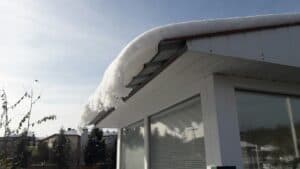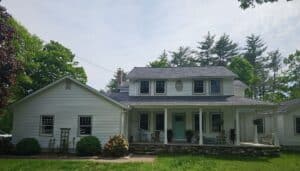
Water collecting on a flat roof might not seem urgent at first glance, but it tends to stick around longer than you’d think. When rainwater or melted snow doesn’t drain properly, it starts pooling in low spots. This standing water is called ponding, and it’s more than just a drainage issue. Over time, it can lead to serious roofing problems like leaks, sagging, and structural wear. The last thing any business wants is unexpected repairs that could have been avoided.
In places like New Hampshire, where summers can be wet and winters bring heavy snow, commercial flat roofs take a lot of weather-related stress. If ponding water isn’t fixed quickly, it can shorten a roof’s lifespan and sometimes even interrupt business operations. Knowing what causes it and how to spot the signs early helps property owners take control before damage sets in.
Causes Of Ponding Water On Flat Roofs
When commercial roofs hold water longer than they should, it usually traces back to a handful of common culprits. Understanding what causes ponding gives you a better shot at stopping it before it becomes a larger issue.
Here are a few typical reasons why ponding happens on a flat roof:
– Poor drainage: If the system that’s supposed to guide water off the roof doesn’t work right, water has nowhere to go. Clogged drains, undersized gutters, or missing scuppers can keep water trapped.
– Roof design issues: Sometimes, the slope of the roof isn’t enough to push water toward the drains. Flat doesn’t mean perfectly level, and if the pitch is off or uneven, puddles can form in low sections.
– Structural settling: Over time, buildings shift. This can cause parts of the roof to dip, which turn into spots where water collects.
– Debris buildup: Leaves, dirt, and other debris can collect on the roof, especially after a storm. This mess can clog drainage paths or create small dams that trap water in place.
Even something as small as a sunken insulation board under the membrane can mess with how water flows. Once these areas start collecting water often, it’s usually just a matter of time before the roofing materials begin wearing down.
Assessing The Damage: How To Identify Ponding Water
Catching ponding water early is key to avoiding bigger problems. You can’t always wait until you see ceiling stains or indoor leaks. That could mean the issue has been there for a while.
When inspecting a commercial flat roof, be on the lookout for these signs:
– Circular or oval stains on the roof surface
– Rings of dirt or debris where water has dried up
– Soft spots, sagging, or depressions in certain roof sections
– Bubbles or blisters in the roofing membrane
You might also notice water pooling around rooftop HVAC units, vents, or skylights. Pooling water near those areas not only affects the roofing but can wear down the equipment too.
The best time to check for ponding is after a heavy rain. This lets you see exactly where water collects and how long it takes to drain. Using moisture meters or infrared scanning also helps identify damp layers below the surface. These tools can uncover trouble spots where water is lingering out of sight.
New Hampshire’s weather shifts often, so even a couple of unnoticed soggy spots could stay damp for days. That’s why regular roof inspections, especially after storms, go a long way toward protecting your property.
Effective Solutions To Fix Ponding Water Issues
Once you’ve found ponding water on your roof, the next step is addressing it before things get worse. Some repairs are easy and cost-effective, while others may call for a little more investment depending on the roof’s condition.
Here are a few proven ways to fix ponding on commercial flat roofs:
– Improve drainage systems: Sometimes ponding starts and stays because of clogged or undersized drains. Clean existing drains, add extra ones if needed, or install edge scuppers to give water more ways to escape.
– Re-slope the roof: A commercial roof needs at least a slight slope for water to move off the surface. Sloped insulation or rebuilt pitch systems can help redirect water toward drains.
– Install roof crickets: These add built-up ridges around areas like skylights, vents, or HVAC units to move water around and away from them.
– Add tapered insulation: Insulation that’s thicker on one side can help prevent water from getting stuck in dips. This is one of the simplest ways to improve drainage with minimal structural changes.
– Keep the roof clean: Leaves and debris can quickly trigger ponding problems. Regular cleaning helps keep drainage systems working and reduces blockages.
The solution you go with depends on a few factors including the age of the roof, how often the ponding appears, and whether there’s existing damage beneath the surface. If structural settling has caused depressions, sloped insulation might not fully solve the issue. On the other hand, if it’s mostly a drainage problem caused by debris, a deep clean and maintenance plan might be enough.
Long-Term Prevention Tips
Fixing ponding once is only part of the solution. Preventing it from coming back, especially in the changing climates of New Hampshire and Southern Maine, can save your business unnecessary stress and expense.
Here are long-term steps you can take to keep ponding at bay:
– Schedule roof inspections at least twice a year, and after severe weather
– Clean off leaves, branches, or built-up debris right after storms
– Check that all drains and scuppers are open and draining properly
– Use durable roofing materials that are made to handle snow, ice, and wet weather patterns
– Watch for sagging or wear in the roof surface, and act quickly on repairs
Flat roofs are easy to overlook until something goes wrong. But even a small puddle that sticks around after every storm can lead to leaks, mold, or worse if ignored. A steady maintenance routine doesn’t need to be complicated. The key is staying consistent and checking trouble spots before damage sets in.
Roof Care That Keeps Your Business Moving
Weather in New Hampshire and Southern Maine doesn’t take breaks, and neither should your roofing upkeep. Whether you’re clearing off fall debris or navigating the freeze-thaw cycle that spring often brings, staying ahead of ponding issues can protect your roof from long-term wear.
Water that sits too long will eventually cause damage. It can affect your ceilings, walls, insulation, and even the structural framing of the building. But with regular checkups and the right solutions in place, those risks lower a lot.
If you’re in charge of a commercial roof, don’t wait for the first leak to take action. Focusing on early detection and proper fixes will help your roofing system last longer, work better, and cost less in the long run. Choosing a trusted contractor for inspections and repairs means your property stays protected no matter what the forecast looks like.
Keeping your roof in top condition takes more than a quick glance after a storm. To stay ahead of damage and take care of moisture problems early, learn how our commercial roofing in New Hampshire can help protect your building year-round. J. Carnes & Son Roofing is ready to keep your roof strong, dry, and built to last.




